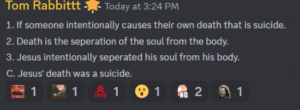Posted by Mockingbird1 on September 14, 1998 at 17:39:13:
PK: From the white paper, not exactly the amorphous body that our evolutionists describe; I’d say it looks like a scientific theory. Would anyone care to compare the theoretical means of speciation with a set of those actually observed? Would anyone care to explain the ‘benefits’ of this theory, beyond the new species of Drosophila?
II WHAT IS EVOLUTION?
Biological (or organic) evolution consists of change (modification) in the hereditary characteristics of groups of organisms over the course of generations. Such groups of organisms, termed populations or species, are formed by division of ancestral populations or species, and the descendant groups then change independently. Hence in a long-term perspective, evolution is the descent, with modification, of different lineages from common ancestors. Thus, the history of evolution has two major components: branching of lineages and change within lineages (including extinction). Initially similar species become ever more different, so that, over the course of sufficient time, they may come to differ profoundly.
The hierarchically organized patterns of commonality among species — such as the common features of all primates, all mammals, all vertebrates, all eukaryotes, and all living things — reflect a history in which all living species can be traced back through time to fewer and fewer common ancestors, and ultimately to the one ancestor of all. It is profoundly wonderful that all forms of life, from viruses to redwoods to humans, are literally related by unbroken chains of physical descent.
This history can be described by the metaphor of the phylogenetic tree (Figure 1), and much of it is recorded in the fossil record. The fossil record documents simple, bacteria-like life as far back as 3.5 billion years, as well as a subsequent history of diversification, origination of major new groups of organisms, and extinctions. The evidence for descent from common ancestors, however, lies not only in the fossil record, but also in the common characteristics of living organisms, including their anatomy, embryological development, and DNA. On such grounds, for example, humans and apes clearly had a relatively recent common ancestor; a more remote common ancestor gave rise to all primates; and successively more remote ancestors gave rise to all mammals, to all tetrapod (four-legged) vertebrates, and to all vertebrates, including fishes.
Evolutionary theory refers to a body of statements about the processes of evolution that are believed to have caused the history of evolutionary events. These processes include both random and nonrandom factors. Biological evolution occurs as the consequence of several fundamental processes.
Variation in characteristics of organisms in a population arises originally by random mutation of DNA (i.e. genes). “Random” here means that the mutations occur irrespective of their possible consequences for survival or reproduction. Variants of a gene that arise by mutation are often called alleles. Genetic variation is augmented by recombination which results in new combinations of alleles at different genetic loci. Variation is also augmented by gene flow, or input of variant genes from other populations of a species.
The basis for evolutionary changes within the population are then changes in the alleles and the proportions (frequencies) of alleles that affect various characteristics. Changes in the proportion of alleles at each locus can be due to two major processes, whereby some individuals leave more descendants than others, and therefore bequeath more genes to subsequent generations. One such process, random genetic drift, results from random (sampling) variation in survival and reproduction of different genotypes. In random genetic drift, frequencies of alleles fluctuate by pure chance. Eventually, one allele will replace others (i.e., be fixed in the population). Genetic drift is most important when the alleles are selectively neutral (i.e., the variants do not substantially differ with respect to survival or reproduction), and it proceeds faster, the smaller the population is. Genetic drift results in evolutionary change but not adaptation.
The other major cause of changes in the frequencies of alleles is natural selection, which is a name for any consistent (nonrandom) difference in the rate of survival or reproduction between variant genes or genotypes. In some cases, one variant survives or reproduces better than others (has higher fitness) almost irrespective of environmental conditions, but in most cases environmental circumstances affect which variant has the higher rate of survival and reproduction. The relevant environmental circumstances depend greatly on an organism’s way of life, and they include not only physical factors such as temperature, but also other species, as well as other members of the organism’s own species, with which it competes, mates, or has other social interactions. A common consequence of natural selection is the process of adaptation, an inherited improvement in the average ability of the population’s members to survive and reproduce in their environment. (The word “adaptation” is also used for a feature that has evolved as a consequence of natural selection.) Natural selection tends to eliminate genes and characteristics that reduce fitness (such as mutations that cause severe birth defects in humans and other species), and it also acts as a sieve that preserves and increases the abundance of combinations of genes and characteristics which would occur only rarely by chance alone. Thus, selection plays a “creative” role, by making the improbable more probable. Often the effect of selection will be to completely replace formerly common genes and characteristics by new ones (directional selection), but under some circumstances, “balancing selection” can maintain several genetic variants indefinitely in a population (a state of genetic polymorphism, such as sickle-cell and “normal” hemoglobins in some human populations in Africa).
Natural selection is the cause of adaptations such as eyes, hormonal controls on development, and courtship behaviors that attract mates, although it cannot produce such adaptations unless mutation and recombination generate genetic variation on which natural selection can act. Over a long enough time, new mutations and recombinations, sorted by genetic drift or natural selection, can alter many characteristics and can alter each characteristic both quantitatively and qualitatively. The result can be indefinitely great change, so that a descendant species differs strikingly from its remote ancestor.
Movement of individuals among populations of a species, followed by interbreeding (i.e., gene flow), allows new genes and characteristics to spread from their population of origin throughout the species as a whole. If gene flow among different, geographically or ecologically separated populations of a species is slight, different genetic changes can transpire. Because the populations experience different histories of mutation, genetic drift, and natural selection (the latter especially if environments differ), they follow different paths of change, diverging in genetic constitution and in the organisms’ characteristics (geographic variation). The differences that accumulate eventually cause the members of different populations, if they should encounter each other (by expanding into new areas), to be reproductively isolated: they do not exchange genes because they do not mate with each other, or if they do, the “hybrid” offspring are inviable or infertile. By anyone’s definition of the term, the different populations are then different species. The profound significance of their becoming different reproductively isolated species (speciation) is that they are likely to evolve independently from then on. Some may give rise to yet other species, which ultimately may become exceedingly different from each other. Successive speciation events, coupled with divergence, give rise to clusters of “twigs” on the phylogenetic tree of living things.
Other processes have also affected the history of biological diversity. Of these, perhaps the most important are differences among species and higher taxa in rates of extinction (e.g. modern insect groups, such as beetles and flies, replacing archaic groups after the Paleozoic era) and origination (e.g., higher speciation rates of rodents than anteaters).
Although each of the separate processes involved in evolution seems relatively simple, evolution is not as straightforward as this summary might make it appear. The various factors of evolution interact in complex ways, and each of them itself has many nuances and complexities. One gene may affect several characters, many genes may affect one character, selection may change in rate or even direction from year to year, or conflicting selection pressures may affect a characteristic. When such complexities are taken into account, it can be quite difficult to predict when and how a characteristic will evolve. Mathematical theory and computer simulation modeling are invaluable tools for understanding how evolution of a characteristic is likely to proceed. A great deal of evolutionary research consists of formulating precise and often quantitative models, and then testing them by experiment or observation.
the White Paper http://www.rci.rutgers.edu/~ecolevol/fulldoc.html#what1
First Response
Define ‘benefit’, then I’ll show you one (nt) SeeJay 19:23:01 9/14/98 (1)
Benefit – a good, something of value (nt) Mockingbird1 22:24:50 9/14/98 (0)
Second Response
Posted by Sumac on September 14, 1998 at 20:41:17:
Please point out where this document restricts speciation to one mechanism. The closest I could find was “If gene flow among different, geographically or ecologically separated populations of a species is slight, different genetic changes can transpire.” and “Other processes have also affected the history of biological diversity. Of these, perhaps the most important are differences among species and higher taxa in rates of extinction (e.g. modern insect groups, such as beetles and flies, replacing archaic groups after the Paleozoic era) and origination (e.g., higher speciation rates of rodents than anteaters).”
These statements seem to say that there are multiple mechanisms of speciation with variable rates of occurrence.
Response to Sumac
Posted by Mockingbird1 on September 14, 1998 at 22:23:26:
PK: They don’t distinguish between allopatric and sympatric. I don’t think they intend to suggest that evolution is the only cause of speciation. However, that is the focus of the excerpt. As you noted, they do write:
“If gene flow among different, geographically or ecologically separated populations of a species is slight, different genetic changes can transpire. Because the populations experience different histories of mutation, genetic drift, and natural selection (the latter especially if environments differ), they follow different paths of change, diverging in genetic constitution and in the organisms’ characteristics (geographic variation). The differences that accumulate eventually cause the members of different populations, if they should encounter each other (by expanding into new areas), to be reproductively isolated: they do not exchange genes because they do not mate with each other, or if they do, the “hybrid” offspring are inviable or infertile.”
PK: I do not read anything other than restriction of gene flow causing speciation in the overview. What I am reading suggests that adaptation adds up to speciation. Granted, adaptation can add up to speciation. The fact remains, that appears to be a factor in 20% of the cases of speciation that I am familiar with. Polyploidy, hybridization, arthogenesis, bacterial infestation, etc. are not even suggested in the professors’ overview. Obviously, extinction of other species is a significant factor in an environment with implications on selection.
PK: I see two possible inferences: 1) either the condensed version, offered by the professors (and consistent w/ mandatory HS Biology treatment of evolution) is simply a grossly inadequate treatment of the theory, or, 2) the evolutionists, here at CARM, confuse their knowledge of biology with the theory of evolution. Possibly both inferences could be wrong or right, to some degree. I still see more Drosophila species as the primary human accomplishment based on the theory as they state it.
PK: They do not state that speciation occurs no other way. The evidence suggests that it seldom occurs the way that the professors describe and they certainly don’t present evolution as a minor player in speciation.
Response to Mockingbird1
Posted by Sumac on September 15, 1998 at 00:39:24:
PK: I do not read anything other than restriction of gene flow causing speciation in the overview.
Restriction of gene flow can happen many different ways. The classical view is that geographical separation is the most important. As you have continued to point out, that may not be the case…at least in the cases that we can observe in real time. You still need quite a bit of time after the restriction of gene flow to observe significant morphological differences (in most cases). I’m having a hard time understanding why you are having a hard time understanding this.
Response to Sumac
Posted by Mockingbird1 on September 15, 1998 at 16:42:04:
S: You still need quite a bit of time after the restriction of gene flow to observe significant morphological differences (in most cases).
PK: I don’t dispute that populations adapt; I insist that they do.
S: Restriction of gene flow can happen many different ways. The classical view is that geographical separation is the most important. As you have continued to point out, that may not be the case…at least in the cases that we can observe in real time. You still need quite a bit of time after the restriction of gene flow to observe significant morphological differences (in most cases). I’m having a hard time understanding why you are having a hard time understanding this.
PK: That I am having a problem in this area is new to me. My problems in other areas are less surprising.
PK: Last week when I was looking for someone to argue evidence on the theory of evolution, I (believe/hope I) attributed the speciation of the apple maggot fly (p. Rhagonella (?)) to evolution. I really do see ecological isolation as consistent w/ the theory of evolution.
PK: In the distant past I challenged evolutionists to predict when the Orangutan populations on Borneo and Sumatra would speciate. I really have seen geographic isolation as part of the theory of evolution.
PK: Continuing past my bone-headedness: in the time it may take to observe speciation via evolution, we may observe more instances of other kinds of speciation, both in known ways and in possibly as yet, unknown ways.
Correction posted by Mockingbird1:
PK: I did not count p. Rhagonella Rhagoletis pomonella, because it is not yet distinguished into two different species. I do allow that looks quite possible. Joseph Boxhorn wrote, “Hybridization studies show that host preferences are inherited, but give no evidence of barriers to mating.” Evidence indicates that assortative mating already occurs.






